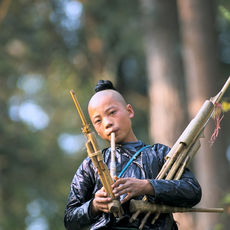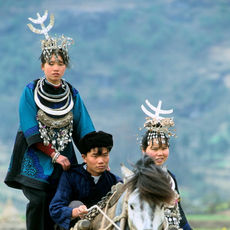CHINA : Guzhang Festival

Festival of Blood
Text & Photography by Eric Pasquier
After decades of Communist repression, the Miao people of southwest China are once again able to practice their ancient beliefs and rituals.
Gunzang – a bloody festival involving ritual buffalo slaughter - has been celebrated for the first time since1923.
Echoing to the sounds of drums and flutes, the people have rekindled a forgotten past. ERIC PASQUIER witnessed this fascinating spectacle.
China’s 55 ethnic minorities represent just 7% of its population, but many of its unique cultures. The Miao once occupied the Yellow River valley, but were displaced by the Han and forced to take refuge in the mountains of Yunnan and Guizhou. Fanzhao, a tiny Miao village in Guizhou province, is home to just 1000 inhabitants.
The road linking it to the world arrived only in 1986, and electricity only in 1999.
"People are very happy about the festival," says Fanzhao’s elected chief Liang Ki Hong, a 40-year-old farmer. "But also sad, because the buffalo are gone". His 16-year-old daughter, Ling Wang Din, is a ‘Silver Princess’, who attends the Gunzang ceremony in flamboyant traditional costume. Her jewels are actually aluminium, as the real family treasures are considered too valuable to be displayed.
During Gunzang, traditionally held every 13 years, ancestors are reincarnated in drums. Their hearts remain inside the instruments, which are hidden in the mountains and brought out for the festivities. But the focus of the event is the ritual buffalo sacrifice.
Their hearts enter paradise, testifying to the village ancestors on behalf of the living. In return, the ancestors deliver good harvests and bring fortune.
The buffalo, specially bred as fighting animals, are raised by individual clans. Each is worth around $800: five times the local average annual wage.
Throughout each sacrifice, musicians “speak” to the ancestors by playing lusheng: huge bamboo flutes whose throbbing notes carry great distances. The largest are over five metres long. A close relation of the family owning the buffalo – usually a young and fit man - brings each animal to the sacrificial area, where it is killed by a family friend with a sword.
The Master of Ceremonies for the sacrifice must be old, rich, the father of both a boy and a girl, and know local tradition and culture.
After each killing, the oldest man of the owning family shakes a branch over the dead animal and tells it: "The village has been kind to you. We had to kill you. You were our best friend. We sacrificed you for our ancestors. One day, we will sacrifice another buffalo for you.” The meat is then divided between families and friends. Gunzang lasts five days in all: two of buffalo fighting, one of the sacrifices, and two of singing and dancing.
"Since the nineties, the government has protected and respected minorities,” sighs Liang Ki Hong.
“But although they have promised money, they haven’t delivered anything. Our culture forms an important part of China. They must help us because only our elders can preserve our past.”
Copyright © Eric Pasquier
All rights reserved.























